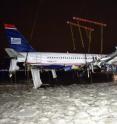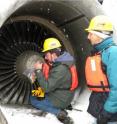Ecologists identify birds struck in Hudson River crash as migratory Canada geese
Related images
(click to enlarge)
Using forensic data from feather remains, scientists have identified the birds that caused the Jan. 15 airline crash into the Hudson River as migratory Canada geese. The study, published online in the journal Frontiers in Ecology and the Environment, will help managers better assess how to prevent such strikes in the future. Led by Peter Marra of the Smithsonian National Zoo's Migratory Bird Center, the researchers applied DNA barcoding, a method that compares a segment of DNA to a database of known genetic material, to the tissue remains of birds extracted from the engines of U.S. Airways flight 1549. Whole feathers were also compared with research specimens at the Smithsonian. The DNA matched that of Canada geese, and the individuals were estimated at about eight pounds each. This information is valuable for engineers to improve the resistance of plane engines to collisions with large birds. But simply uncovering the species of bird isn't enough.
"It's important to not only know what species of birds are involved in collisions, but to also understand the role that migration plays in the larger picture," said Carla Dove, a coauthor and program director at Smithsonian's Feather Identification Laboratory. "The more information we are able to gather in cases like this, the more we will be able to reduce the risks of birdstrikes in the future."
The researchers then used a stable isotope analysis to identify the type of hydrogen found in the birds' feathers. Hydrogen isotopes vary in animals' systems and are useful as geographic markers, since they can reflect the type of vegetation in an animal's diet. The scientists found that the isotopes were not similar to isotopes found in feathers of birds that reside year-round near La Guardia Airport, where the plane crashed. Instead, the isotopes identified the birds as originating in the Labrador region of the Canadian province Newfoundland and Labrador.
"Knowing that the birds were migratory is crucial to developing management strategies," Marra says. If most airplane collisions involve resident geese, then tactics such as population reduction and habitat modification are appropriate to reduce the majority of birdstrikes. On the other hand, if collisions occur mostly with migrating birds, then other approaches, such as improved radar technology, would be more useful.
The trouble is, says Marra, that the Federal Aviation Administration doesn't require reporting of birdstrikes. More than 7,400 birdstrikes were reported in the US in 2007, but this represents only an estimated 20 percent of total collisions; the other estimated 80 percent go undocumented. Worldwide, birdstrikes cause an estimated $1.1 billion in damage per year, and since 1988 have caused 229 deaths.
"Reporting and recording the frequency and timing of collisions is critical," Marra says. "Otherwise we are missing valuable information that could reveal patterns of frequency, location and species involved – all information that is essential to reducing the frequency of birdstrikes."
Source: Ecological Society of America
Articles on the same topic
- Scientists determine geese involved in Hudson River plane crash were migratoryMon, 8 Jun 2009, 15:09:52 UTC
Other sources
- Canada geese brought down flight 1549from UPIWed, 10 Jun 2009, 17:07:06 UTC
- Canadian geese brought down flight 1549from UPIWed, 10 Jun 2009, 14:49:03 UTC
- Canada geese confirmed as culprit in US Airways crash-landingfrom LA Times - ScienceMon, 8 Jun 2009, 20:56:27 UTC
- Case Closed: Scientists Nab Birds That Brought Down Airplanefrom Science NOWMon, 8 Jun 2009, 19:21:06 UTC
- Geese Involved In Hudson River Plane Crash Were Migratoryfrom Science DailyMon, 8 Jun 2009, 17:21:13 UTC
- Migratory Geese Downed Flight 1549 in Hudson Riverfrom Live ScienceMon, 8 Jun 2009, 16:35:23 UTC
- Scientists determine geese involved in Hudson River plane crash were migratoryfrom PhysorgMon, 8 Jun 2009, 15:07:56 UTC

